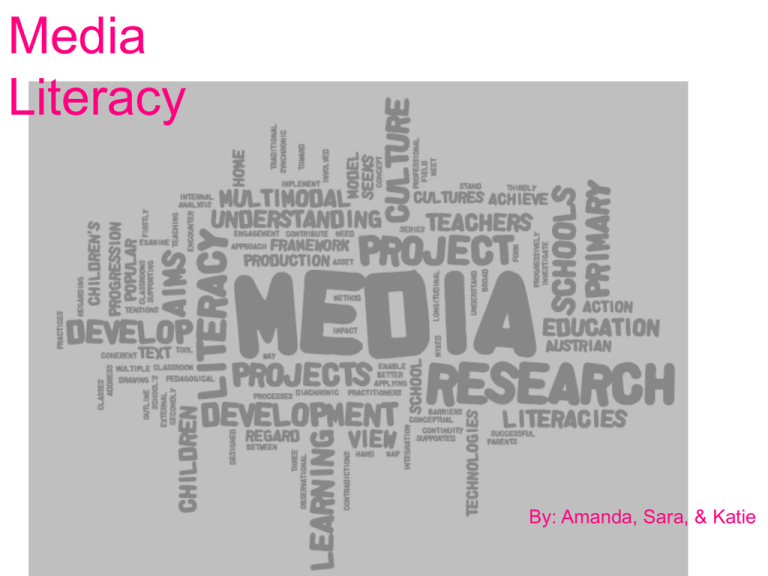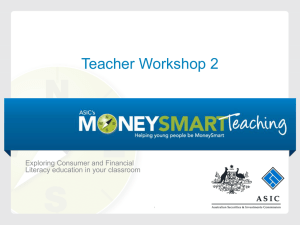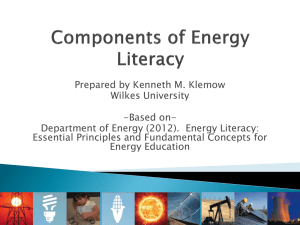Presentation (Blog)
advertisement

Media Literacy By: Amanda, Sara, & Katie What Does Media Literacy Mean? • “Media literacy refers to the ability to access, analyze, evaluate and create media messages of all kinds.” Being Media Literate Can Help Us: • Understand how media messages create meaning • Identify who created a particular media message • Recognize what the media maker wants us to believe or do • Name the "tools of persuasion" used • Recognize bias, spin, misinformation and lies • Discover the part of the story that's not being told • Evaluate media messages based on our own experiences, beliefs and values • Create and distribute our own media messages • Become advocates for change in our media system Why Should We Teach Media Literacy? • Media literacy education helps us to develop critical thinking skills and involve an active participation in our media culture. • The goal is to give people greater freedom by empowering them to access, analyze, evaluate, and create media. • – In schools: “Educational standards in many states like language arts, social studies, and other subjects include the skills of accessing, analyzing and evaluating information found in media. These are media literacy skills. Teachers know that students like to examine and talk about their own media, and they've found that media literacy is an engaging way to explore a wide array of topics and issues.” • – In public life: Media literacy helps us understand how media create cultures, and how the "media monopoly” (the handful of giant corporations that control most of our media) affects our politics and our society. Media literacy encourages and empowers people to change our media system, and to create new, more just and more accessible media networks. Media Literacy Basic Concepts: • The study and practice of media literacy is based on a number of fundamental concepts about media messages, our media system, and the role of media literacy in bringing about change. Understanding these concepts is an essential first step in media literacy education. Here are some basic concepts of media literacy that focus on how media affect us. 1. Media Constructs Our Culture • Our society and culture is shaped by the information and images we receive via the media. Before media literacy existed, our culture’s storytellers were people such as family, friends, and others in our community. • For many people today, the most powerful storytellers are television, movies, music, video games, and the Internet. 2. Media Messages Affect Our Thoughts, Attitudes, & Actions • We don’t like to admit it, but all of us are affected by advertising, news, movies, pop music, video games, and other forms of media. • That’s why media are such a powerful cultural force, and why the media industry is such big business. 3. Media Use of the “Language of Persuasion” • All media messages try to persuade us to believe or do something. – News, documentary films, and nonfiction books all claim to be telling the truth. – Advertising tries to get us to buy products. – Novels and TV dramas go to great lengths to appear realistic. • To do this, they use specific techniques (like flattery, repetition, fear, and humor) we call “the language of persuasion.” 4. Media Constructs Fantasy Worlds • While fantasy can be pleasurable and entertaining, it can also be harmful. – Movies, TV shows, and music videos sometimes inspire people to do things that are unwise, antisocial, or even dangerous. • At other times, media can inspire our imagination. – Advertising constructs a fantasy world where all problems can be solved with a purchase. • Media literacy helps people to recognize fantasy and constructively integrate it with reality. 5. No One Tells the Whole Story • Every media maker has a point of view. Every good story highlights some information and leaves out the rest. Often, the effect of a media message comes not only from what is said, but from what part of the story is not told. 6. Media Messages Contain “Texts” & “Subtexts” • The text is the actual words, pictures and/or sounds in a media message. • The subtext is the hidden and underlying meaning of the message. 7. Media Messages Reflect the Values & Viewpoints of Media Makers • Everyone has a point of view. • Our values and viewpoints influence our choice of words, sounds and images we use to communicate through media. 8. Individuals Construct Their Own Meanings From Media • Although media makers attempt to convey specific messages, people receive and interpret them differently, based on their own prior knowledge and experience, their values, and their beliefs. • This means that people can create different subtexts from the same piece of media. All meanings and interpretations are valid and should be respected. 9. Media Messages Can Be Decoded • By “deconstructing” media, we can figure out who created the message, and why they created it. 10. Media Literate People Are Active Consumers of Media • Many forms of media, like television, seek to create passive, impulsive consumers. • Media literacy helps people consume media with a critical eye, evaluating sources, intended purposes, persuasion techniques, and deeper meanings. Deconstructing Media Messages • All media messages such as TV shows, newspapers, movies, advertisements, etc., are constructed by people. • Deconstruction means to closely examine and “take apart” media messages to understand how they work. – There is no one “correct” way to deconstruct a media message; each of us interprets media differently, based on our own knowledge, beliefs, experiences, and values. Just be prepared to explain your interpretation. Key Concepts for Deconstructing Media 1. Source • All media messages are constructed by people. • The creator could be an individual writer, photographer or blogger. • The “creator” is really the client, the company or organization that’s paying for the ad. • Questions to ask: Whose message is this? Who has control over the content? 2. Audience • Media messages are intended to reach audiences. • Most media messages are designed to reach specific groups of people, defined by age, gender, class, interests, and other factors, called the “target audience.” • Questions to ask: Who is the message for? What age is it intended to affect? 3. Text • The text of any piece of media is what you actually see and/or hear. – It can include written or spoken words, pictures, graphics, moving images, sounds, and the arrangement or sequence of all of these elements. • Sometimes the text is called the “story” or “manifest text.” • Questions to ask? What does the message say or tell you? What does the message show? 4. Subtext • The “subtext” is an individual interpretation of a media message. • While media makers often create texts that suggest certain subtexts, each person creates their own subtext (interpretation) based on their previous experiences, knowledge, opinions, attitudes, and values. – Thus, two people interpreting the same text can produce two very different subtexts. • Questions to ask: What do you think this message is trying to say? Does the message go with or against your beliefs or values? 5. Persuasion Techniques • Persuasion is a technique that tries to tell us to believe or do something. • If we can spot the techniques being used, we’re less likely to be persuaded, and more likely to think for ourselves. • Questions to ask? What is the message trying to make you understand? Is the message intending you to do something or think in a certain way? 6. Point of View • No one tells the whole story; everyone tells part of the story from their point of view. • Deconstructing a media message can expose the values and biases of the media maker, and uncover powerful ideological and value messages. • Questions to ask: Is there only one viewpoint? If so, what are some possible other viewpoints that go against this message? Activity 1 Let’s Deconstruct a Message Deconstruction Questions: 1. Whose message is this? Who is the message for? 2. Who created or paid for it? Why? 3. Who is the “target audience”? What are the clues (words, images, sounds, etc.)? 4. What “tools of persuasion” are used? 5. What part of the story is not being told? One specific example that media literacy has an affect on society is: Gender Roles Activity 2 Write Down Your Answers to the Questions on the Worksheet Gender Questions: 1. How can parents pressure us to act like a man? (Preference for the color blue, as opposed to pink, "don't cry," "be strong," go out for sports, etc.) 2. Do you think the message to act like a man or woman has changed in the twenty years? 3. What are some ways men need to look like or act to be manly? 4. What are some ways women need to look like or act to be considered feminine? 5. What are some different ways in which men and women act differently in society? Studio Project Exposing Gender Stereotypes Disney Movie Clips: “Beauty and the Beast” • http://www.youtube.com/watch?v=vsRDfiVP4 eM&feature=player_embedded – (Bar scene: start to 2:39) • http://www.youtube.com/watch?v=MVovQfq 7U0w&feature=player_embedded – (Town scene: start from 3:06 to 4:46) Our Project: “Gender Roles in Film” Bibliography “Belle (Little Town)-Beauty and the Beast (1991)” Online Posting. YouTube, 10 Sept. 2008. Web. 12 Dec. 2011. <http://www.youtube.com/watch?v_MVovQfq7U0w&feature=player_embedded.> . Considine, David. “An Introduction to Media Literacy: The What, Why and How To’s.” Telemedium. The Journal of Media Literacy 41.2, 1995. Web. 12 Dec. 2011. <http://www.ced.appstate.edu/departments/ci/programs/edmedia/medialit/articl e.html>. “Exposing Gender Stereotypes.” Media Awareness Network. 2010. Web. 12 Dec. 2011. <http://www.media-awareness.ca/english/resources/educational/lessons/ secondary/genderportrayal/exposinggender.cfm>. “Gaston-Beauty and the Beast (1991).” Online Posting. YouTube, 5 Sept. 2008. Web. 12 Dec. 2011.<http://www.youtube.com/watch v=vsRDfiVP4eM&feature=playerem bedded>. “Introduction to Media Literacy.” Media Literacy Project. Web. 12 Dec. 2011. <http://medialiteracyproject.org>.







